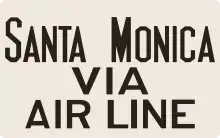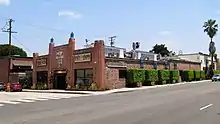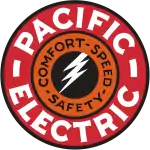Santa Monica Air Line
The Santa Monica Air Line was an interurban railroad operated by the Pacific Electric between Santa Monica and downtown Los Angeles. It operated between 1909 and 1953.[2] Most of the route is now used by the E Line (Los Angeles Metro).
| Santa Monica Air Line | |||||||||||||||||||||||||||||||||||||||||||||||||||||||||||||||||||||||||||||||||||||||||||||||||||||||||||||||||||||||||||||||||||||||||||||||||||||||||||||||||||||||
|---|---|---|---|---|---|---|---|---|---|---|---|---|---|---|---|---|---|---|---|---|---|---|---|---|---|---|---|---|---|---|---|---|---|---|---|---|---|---|---|---|---|---|---|---|---|---|---|---|---|---|---|---|---|---|---|---|---|---|---|---|---|---|---|---|---|---|---|---|---|---|---|---|---|---|---|---|---|---|---|---|---|---|---|---|---|---|---|---|---|---|---|---|---|---|---|---|---|---|---|---|---|---|---|---|---|---|---|---|---|---|---|---|---|---|---|---|---|---|---|---|---|---|---|---|---|---|---|---|---|---|---|---|---|---|---|---|---|---|---|---|---|---|---|---|---|---|---|---|---|---|---|---|---|---|---|---|---|---|---|---|---|---|---|---|---|---|---|
 | |||||||||||||||||||||||||||||||||||||||||||||||||||||||||||||||||||||||||||||||||||||||||||||||||||||||||||||||||||||||||||||||||||||||||||||||||||||||||||||||||||||||
 The Air Line looking west from Ivy station (later Culver Junction), with the junction and station building in the foreground, 1905 | |||||||||||||||||||||||||||||||||||||||||||||||||||||||||||||||||||||||||||||||||||||||||||||||||||||||||||||||||||||||||||||||||||||||||||||||||||||||||||||||||||||||
| Overview | |||||||||||||||||||||||||||||||||||||||||||||||||||||||||||||||||||||||||||||||||||||||||||||||||||||||||||||||||||||||||||||||||||||||||||||||||||||||||||||||||||||||
| Owner | Southern Pacific Railroad | ||||||||||||||||||||||||||||||||||||||||||||||||||||||||||||||||||||||||||||||||||||||||||||||||||||||||||||||||||||||||||||||||||||||||||||||||||||||||||||||||||||||
| Locale | Los Angeles | ||||||||||||||||||||||||||||||||||||||||||||||||||||||||||||||||||||||||||||||||||||||||||||||||||||||||||||||||||||||||||||||||||||||||||||||||||||||||||||||||||||||
| Termini | Pacific Electric Building Santa Monica, California | ||||||||||||||||||||||||||||||||||||||||||||||||||||||||||||||||||||||||||||||||||||||||||||||||||||||||||||||||||||||||||||||||||||||||||||||||||||||||||||||||||||||
| Stations | 15 | ||||||||||||||||||||||||||||||||||||||||||||||||||||||||||||||||||||||||||||||||||||||||||||||||||||||||||||||||||||||||||||||||||||||||||||||||||||||||||||||||||||||
| Service | |||||||||||||||||||||||||||||||||||||||||||||||||||||||||||||||||||||||||||||||||||||||||||||||||||||||||||||||||||||||||||||||||||||||||||||||||||||||||||||||||||||||
| Type | Interurban | ||||||||||||||||||||||||||||||||||||||||||||||||||||||||||||||||||||||||||||||||||||||||||||||||||||||||||||||||||||||||||||||||||||||||||||||||||||||||||||||||||||||
| System | |||||||||||||||||||||||||||||||||||||||||||||||||||||||||||||||||||||||||||||||||||||||||||||||||||||||||||||||||||||||||||||||||||||||||||||||||||||||||||||||||||||||
| Operator(s) | |||||||||||||||||||||||||||||||||||||||||||||||||||||||||||||||||||||||||||||||||||||||||||||||||||||||||||||||||||||||||||||||||||||||||||||||||||||||||||||||||||||||
| History | |||||||||||||||||||||||||||||||||||||||||||||||||||||||||||||||||||||||||||||||||||||||||||||||||||||||||||||||||||||||||||||||||||||||||||||||||||||||||||||||||||||||
| Opened | May 26, 1909[1] | ||||||||||||||||||||||||||||||||||||||||||||||||||||||||||||||||||||||||||||||||||||||||||||||||||||||||||||||||||||||||||||||||||||||||||||||||||||||||||||||||||||||
| Closed | October 26, 1953 | ||||||||||||||||||||||||||||||||||||||||||||||||||||||||||||||||||||||||||||||||||||||||||||||||||||||||||||||||||||||||||||||||||||||||||||||||||||||||||||||||||||||
| Technical | |||||||||||||||||||||||||||||||||||||||||||||||||||||||||||||||||||||||||||||||||||||||||||||||||||||||||||||||||||||||||||||||||||||||||||||||||||||||||||||||||||||||
| Line length | 16.88 mi (27.17 km) | ||||||||||||||||||||||||||||||||||||||||||||||||||||||||||||||||||||||||||||||||||||||||||||||||||||||||||||||||||||||||||||||||||||||||||||||||||||||||||||||||||||||
| Track gauge | 1,435 mm (4 ft 8 1⁄2 in) standard gauge | ||||||||||||||||||||||||||||||||||||||||||||||||||||||||||||||||||||||||||||||||||||||||||||||||||||||||||||||||||||||||||||||||||||||||||||||||||||||||||||||||||||||
| Electrification | 600 V DC Overhead lines | ||||||||||||||||||||||||||||||||||||||||||||||||||||||||||||||||||||||||||||||||||||||||||||||||||||||||||||||||||||||||||||||||||||||||||||||||||||||||||||||||||||||
| |||||||||||||||||||||||||||||||||||||||||||||||||||||||||||||||||||||||||||||||||||||||||||||||||||||||||||||||||||||||||||||||||||||||||||||||||||||||||||||||||||||||
Route
Los Angeles to Culver Junction
Beginning at the Pacific Electric Building at Sixth and Main streets, the line crossed Los Angeles Street on a viaduct to reach San Pedro Street, where it turned south. It turned from San Pedro onto Ninth Street and ran to a right-of-way. At 25th Street and Long Beach Boulevard at what was called Amoco (American Olive Company) Junction, the Air Line left the Watts main route and went west on a single track right-of-way diagonally across the city grid until Flower Street, where it joined Exposition Boulevard. At the west end of Exposition, the route followed Jefferson Boulevard to La Cienega, where it generally followed Washington and National Boulevards until Culver Junction.[3]
Culver Junction to Santa Monica
The route turned north until it crossed Overland Avenue, continued on a right-of-way between Exposition and Olympic before reaching Colorado and paralleling that road to Santa Monica. The line curved to the southeast to meet Pico just west of Main Street. It ended south of Main and Hollister at the Ocean Park car house.[3]

The table shows stops on the line in 1911, with major depots in bold:
| Station | Mile |
|---|---|
| Los Angeles | 0.00 |
| Nevin | 2.62 |
| Hooper | 3.05 |
| San Pedro Street | 3.77 |
| Jefferson | 4.18 |
| Grand Avenue | 4.54 |
| University | 5.40 |
| 11th Avenue | 7.68 |
| Sentous | 10.04 |
| Culver Junction (Venice Blvd and Culver Blvd) |
11.16 |
| Palms | 12.20 |
| Talamantes | 13.73 |
| Home Junction | 14.87 |
| Soldiers' Home | 15.87 |
| Bergamot | 15.25 |
| Sunset | 16.18 |
| Santa Monica | 16.88 |
| Tool House | 17.54 |
| Ocean Park | 19.20 |
| Inglewood | 26.43 |
History
The line was built in 1875 as the steam-powered Los Angeles and Independence Railroad, intended to bring mined ore to ships in Santa Monica harbor's Long Wharf and as a passenger excursion train to the beach. Purchased by Southern Pacific Railroad, it was leased to the Los Angeles Pacific Railroad for electric passenger and light freight use in 1909 – the inaugural run was made on May 26 that year.[1] Pacific Electric bought the line in 1911, along with all the other lines owned by Los Angeles Pacific. The Santa Monica harbor Long Wharf was closed to shipping traffic in 1913.[4][5][6]
Service decline and end
With sparse population along much of the route, service on the Air Line was reduced as early as 1924, with passenger cars running only during rush hours.[6] At that point most passengers traveled to Santa Monica on a different rail line which ran primarily on Santa Monica Boulevard.
Passenger service on the Air Line was discontinued on October 26, 1953;[6] however, freight service remained.[7] Because the Air Line route was also connected to the Santa Monica Boulevard line via tracks on Sepulveda Boulevard, it was the only way for freight trains to reach West Los Angeles, Beverly Hills and Hollywood warehouses (usually at night due to city regulations).

As the use of rail for transporting freight gradually declined, the tracks along Santa Monica and Sepulveda boulevards were removed and service became sparse. The tracks alongside Exposition Park occasionally also served a special purpose to hold circus trains throughout the 1980s and to store various companies' passenger cars during the 1984 Olympic Games. The final freight run was from Fisher Lumber in Santa Monica in the morning of Friday, March 11, 1988.[8] Power was provided by the Ivy Substation at 600 volts direct current until operations were converted to diesel engines.[9]
After abandonment, ownership was maintained by Southern Pacific,[3] which leased various portions of the land for semi-permanent structures. By the mid-1990s parking lots, storage facilities and some retail buildings had almost completely covered the tracks west of Sepulveda Boulevard - with unused signal cantilevers and crossing gates being the only clue to its former existence. East of Sepulveda Boulevard, tracks, bridges and tunnels remained intact but overgrown.
A lone Southern Pacific Railroad boxcar was marooned on a freight siding which once serviced a warehouse at 10151 National Boulevard, originally the Great Western Biscuit Company and later the publications division of Douglas Aircraft Company. In 2005 the building was leveled and the boxcar cut apart and removed to make way for Price Self-Storage.[10]
Replacement
The right-of-way was purchased by what is now Los Angeles Metro in 1990.[11] Track replacement and various construction tasks began in 2006, and the first phase of the "Expo Line" from downtown Los Angeles to Culver City opened in April 2012.[12] Service for the second phase to Santa Monica began on May 20, 2016.[13]
While most parts of the Air Line have been replaced in reconstruction, two major structures from those days remain: (1) The steel bridge over National Boulevard was deemed structurally sound and was repurposed in conjunction with a new bridge for a second track, and (2) the tunnel under the Santa Monica Freeway was put back in use.
See also
References
- Sherman, R.P. (25 May 1909). "Air Line Flyer Service Put On To Santa Monica". Los Angeles Herald. p. 5. Retrieved 8 September 2020.
- "Santa Monica Air Line Last Run (Meets Moron) May, 2014".
- "1981 Inventory of Pacific Electric Routes" (PDF). Caltrans. February 1982. Retrieved 3 June 2020.
- SANTA MONICA GETS NEW TRAIN SERVICE BOARD OF TRADE SECURES ADDED FLYERS, Los Angeles Herald, August 16, 1908, page 7
- "Los Angeles Herald 25 June 1904 — California Digital Newspaper Collection". ucr.edu.
- "Pacific Electric Santa Monica Air Line". erha.org. Retrieved September 7, 2020.
- Schwieterman, Joseph P. (2004). When the Railroad Leaves Town. Kirksville, MO: Truman State University Press. pp. 75–79. ISBN 9781931112130.
- Morgenthaler, Anne, END OF THE LINE—The last train out of SM blows a final whistle, The Santa Monica Outlook, March 14, 1988
- "Los Angeles Pacific Company Ivy Park Substation". National Register of Historic Places.
- George Garrigues, Los Angeles's The Palms Neighborhood, Arcadia Press, 2009, pages 30 and 32 ISBN 978-0-7385-6993-2
- "Mid City Westside Transit Draft EIS/EIR: 1.0 History, purpose and need" (PDF). Los Angeles County Metropolitan Transportation Authority.
- Weikel, Dan; Bloomekatz, Ari (April 27, 2012). "Expo Line launches rail service push to Westside". LA Times. Retrieved 15 July 2017.
- Zeller, Heidi (March 30, 2015). "Art for the Expo Line: installation at Expo/Sepulveda Station". The Source. Los Angeles County Metropolitan Transportation Authority. Retrieved March 31, 2015.
External links
- Essay on the Santa Monica Air Line at Abandonedrails.com
- Information on the wigwag cantilevers at Trainweb.org/dansrailpix
- Santa Monica Air Line history page at the Electric Railway Historical Association of Southern California
- Historic photos ca. 1953 of the final days of passenger service on the Santa Monica Air Line
- Website discussion of route with photographs of equipment in 1930s-40s photographs of the PE's Santa Monica Air Line
